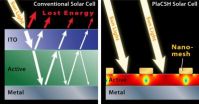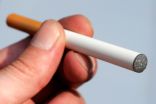(Press-News.org) Princeton researchers have found a simple and economic way to nearly triple the efficiency of organic solar cells, the cheap and flexible plastic devices that many scientists believe could be the future of solar power.
The researchers, led by electrical engineer Stephen Chou, were able to increase the efficiency 175 percent by using a nanostructured "sandwich" of metal and plastic that collects and traps light. Chou said the technology also should increase the efficiency of conventional inorganic solar collectors, such as standard silicon solar panels, although he cautioned that his team has not yet completed research with inorganic devices.
Chou said the research team used nanotechnology to overcome two primary challenges that cause solar cells to lose energy: light reflecting from the cell, and the inability to fully capture light that enters the cell.
With their new metallic sandwich, the researchers were able to address both problems. The sandwich – called a subwavelength plasmonic cavity – has an extraordinary ability to dampen reflection and trap light. The new technique allowed Chou's team to create a solar cell that only reflects about 4 percent of light and absorbs as much as 96 percent. It demonstrates 52 percent higher efficiency in converting light to electrical energy than a conventional solar cell.
That is for direct sunlight. The structure achieves even more efficiency for light that strikes the solar cell at large angles, which occurs on cloudy days or when the cell is not directly facing the sun. By capturing these angled rays, the new structure boosts efficiency by an additional 81 percent, leading to the 175 percent total increase.
The physics behind the innovation is formidably complex. But the device structure, in concept, is fairly simple.
The top layer, known as the window layer, of the new solar cell uses an incredibly fine metal mesh: the metal is 30 nanometers thick, and each hole is 175 nanometers in diameter and 25 nanometers apart. (A nanometer is a billionth of a meter and about one hundred-thousandth of human hair). This mesh replaces the conventional window layer typically made of a material called indium-tin-oxide (ITO).
The mesh window layer is placed very close to the bottom layer of the sandwich, the same metal film used in conventional solar cells. In between the two metal sheets is a thin strip of semiconducting material used in solar panels. It can be any type – silicon, plastic or gallium arsenide – although Chou's team used an 85-nanometer-thick plastic.
The solar cell's features – the spacing of the mesh, the thickness of the sandwich, the diameter of the holes – are all smaller than the wavelength of the light being collected. This is critical because light behaves in very unusual ways in sub-wavelength structures. Chou's team discovered that using these subwavelength structures allowed them to create a trap in which light enters, with almost no reflection, and does not leave.
"It is like a black hole for light," Chou said. "It traps it."
The team calls the system a "plasmonic cavity with subwavelength hole array" or PlaCSH. Photos of the surface of the PlaCSH solar cells demonstrate this light-absorbing effect: under sunlight, a standard solar power cell looks tinted in color due to light reflecting from its surface, but the PlaCSH looks deep black because of the extremely low light reflection.
The researchers expected an increase in efficiency from the technique, "but clearly the increase we found was beyond our expectations," Chou said.
Chou and graduate student Wei Ding reported their findings in the journal Optics Express, published online Nov. 28, 2012. Their work was supported in part by the Defense Advanced Research Projects Agency, the Office of Naval Research and the National Science Foundation.
The researchers said the PlaCSH solar cells can be manufactured cost-effectively in wallpaper-size sheets. Chou's lab used "nanoimprint," a low-cost nanofabrication technique Chou invented 16 years ago, which embosses nanostructures over a large area, like printing a newspaper.
Beside the innovative design, the work involved optimizing the system. Getting the structure exactly right "is critical to achieving high efficiency," said Ding, a graduate student in electrical engineering.
Chou said that the development could have a number of applications depending on the type of solar collector. In this series of experiments, Chou and Ding worked with solar cells made from plastic, called organic solar cells. Plastic is cheap and malleable and the technology has great promise, but it has been limited in commercial use because of organic solar cells' low efficiency.
In addition to a direct boost to the cells' efficiency, the new nanostructured metal film also replaces the current ITO electrode that is the most expensive part of most current organic solar cells.
"PlaCSH also is extremely bendable," Chou said. "The mechanical property of ITO is like glass; it is very brittle."
INFORMATION:
The nanostructured metal film is also promising for silicon solar panels that now dominate the market. Because the PlaCSH sandwich captures light independent of what electricity-generating material is used as the middle layer, it should boost efficiency of silicon panels as well. It also can reduce the thickness of the silicon used in traditional silicon solar panels by a thousand-fold, which could substantially decrease manufacturing costs and allow the panels to become more flexible.
Chou said the team plans further experiments and expects to increase the efficiency of the PlaCSH system as they refine the technology.
Tiny structure gives big boost to solar power
2012-12-07
ELSE PRESS RELEASES FROM THIS DATE:
Valuable tool for predicting pain genes in people
2012-12-07
Scientists in Australia and Austria have described a "network map" of genes involved in pain perception, with remarkable similarity from fruit flies to people. The work should help identify new analgesic drugs.
Dr Greg Neely from the Garvan institute of Medical Research in Sydney and Professor Josef Penninger from the Austrian Academy of Sciences in Vienna had previously screened the 14,000 genes in the fly genome and identified 580 genes identified with heat perception. In the current study, using a database from the US National Centre for Biotechnology Information, ...
Severe acute kidney injuries rise rapidly nationwide
2012-12-07
Severe acute kidney injuries are becoming more common in the United States, rising 10 percent per year and doubling over the last decade, according to a retrospective study at the University of California, San Francisco (UCSF).
The study, to be published online this week in the Journal of the American Society of Nephrology, analyzed information from a national database that monitors all causes of hospitalizations and used this data to estimate the total number of acute kidney injuries in the United States that were severe enough to require a patient to be placed on dialysis. ...
Fasting may benefit patients with epilepsy, Johns Hopkins Children's Center study suggests
2012-12-07
Children with persistent and drug-resistant seizures treated with the high-fat, low-carbohydrate ketogenic diet may get an added therapeutic benefit from periodic fasting, according to a small Johns Hopkins Children's Center study.
The results, published online Dec. 3 in the journal Epilepsy Research, suggest the ketogenic diet and fasting can work in tandem to reduce seizures but appear do so through different mechanisms -- a finding that challenges the longstanding assumption that the two share a common mechanism.
"Our findings suggest that fasting does not merely ...
Paradox of aging: The older we get, the better we feel?
2012-12-07
Presently, there are about 40 million Americans over the age of 65, with the fastest-growing segment of the population over 80 years old. Traditionally, aging has been viewed as a period of progressive decline in physical, cognitive and psychosocial functioning, and aging is viewed by many as the "number one public health problem" facing Americans today.
But this negative view of aging contrasts with results of a comprehensive study of 1,006 older adults in San Diego by researchers from the University of California, San Diego School of Medicine and Stanford University. ...
New IDSA guidelines aim to reduce death, disability, and cost of prosthetic joint infections
2012-12-07
[EMBARGOED FOR DEC. 7, 2012, ARLINGTON, Va.] – Of the one million people each year who get hips and knees replaced, as many as 20,000 will get an infection in the new joint, a number that is expected to skyrocket in the next 20 years. Multispecialty physician teams need to work together to reduce disability, death and costs associated with the ever-growing number of these prosthetic joint infections, note the first guidelines on the topic being released by the Infectious Diseases Society of America (IDSA).
"There are very few things that improve quality of life as much ...
Antibiotic-eating bug unearthed in soil
2012-12-07
It's well known how bacteria exposed to antibiotics for long periods will find ways to resist the drugs—by quickly pumping them out of their cells, for instance, or modifying the compounds so they're no longer toxic.
Now new research has uncovered another possible mechanism of antibiotic "resistance" in soil. In a paper published on Dec. 6 in the Journal of Environmental Quality, a group of Canadian and French scientists report on a soil bacterium that breaks down the common veterinary antibiotic, sulfamethazine, and uses it for growth.
Certain soil bacteria are already ...
Nicaragua Participates in the 2012 Outsource to LAC
2012-12-07
Nicaragua is currently participating in the Latin American and the Caribbean (LAC) Offshoring and Outsourcing Summit, held in Medellin Colombia from December 4th to the 6th, whose objective is to promote the development of the outsourcing and offshoring industry in the region and establish key contacts between international companies interested in seeking new outsourcing destinations.
The Nicaraguan delegation participating in the summit includes representatives from PRONicaragua, the official investment and export promotion agency of the Government of Nicaragua, and ...
EcigaretteReviewed.com Stands up to Misinformation Surrounding Electronic Cigarettes
2012-12-07
The trusted electronic cigarette review website EcigaretteReviewed.com has hit back against false and misleading claims surrounding electronic cigarettes. News reports from around the world have spurred on the uncertainty surrounding the new nicotine-vaporizing devices, but a glut of scientific research has shown that there is very little to worry about with regards to their safety. It's been claimed that the presence of nitrosamines and diethylene glycol in e-cigarettes renders them a potential health hazard, but the website rallies against these claims, ultimately placing ...
Prompt Proofing Blog Post: Grammar Tips - Further or Farther?
2012-12-07
This one causes confusion for a lot of people. The simplest way to approach it is to use farther when you are talking about physical distance and further when speaking figuratively.
For example:
It would be quicker to fly to Toronto; New York is much farther.
I will have to go a few miles farther to find a gas station open at this hour.
Compare:
If you want to take this further then you can write to the Board of Governors.
We can discuss this further next time.
One easy way to remember is to use farther when you are comparing two places that are far ...
Now Offering Affordable Medical Alert Service by HBD Business Solution
2012-12-07
HBD Business Solutions, a sister company of Help Button Designs, LLC offers affordable Medical Alert Service with round the clock monitoring 24/7/365, Certified Response Associates with two responders per call, no contracts, easy installation, water proof pendants, and customized care plans to connect with family first in the event of an emergency.
The service works by first pressing your waterproof Help Button and you will instantly be connected to a Certified Specialist. Next a Care Specialist assists you any time of the day in any given situation whether emergency ...



